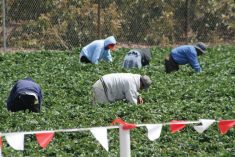Working remotely from home has been one of the most prominent changes caused by the pandemic, but there are other workforce shifts in play — including ones that will affect agriculture, says a senior vice-president of RBC.

“One of the things we’re detecting and hearing from a number of sectors is that this crisis has accelerated trends that were already underway,” said John Stackhouse. “In some ways, it’s kind of brought forward the future.”
Since it has been relatively unscathed, “agriculture will be one of the sectors that accelerates into and through the recovery,” he said.
“It has the resilience, the demand, and the capacity to accelerate. It will be important for governments and society to invest in the capital, the technology, and the skills required for that acceleration.”
Investment would speed adoption of technology — in particular, automation — that allows farmers to produce more with less land, labour, and inputs.
Read Also

Farming Smarter receives financial boost from Alberta government for potato research
Farming Smarter near Lethbridge got a boost to its research equipment, thanks to the Alberta government’s increase in funding for research associations.
But the pandemic has also boosted the industry’s profile among job searchers.
“This crisis has probably opened people’s eyes to the opportunities and the attractiveness of working in different areas, including food production and agriculture,” said Stackhouse.
But it has also underscored the sector’s labour challenges, said Jennifer Wright, senior HR adviser at the Canadian Agricultural Human Resources Council, which forecasts the industry will be short 123,000 workers by 2029 (double today’s number).
“There are many farmers and producers who were already feeling that challenge to attract and retain enough workers on the farm,” said Wright. “When the pandemic came along, it just made that even more difficult.”
But like Stackhouse, Wright sees an opportunity to attract workers displaced from other sectors.
“That awareness has been way higher over the last month or so,” she said. “There’s been a lot more effort as well to try and connect the agriculture industry with currently displaced workers who may have worked in other industries.”
The provincial government has created a job bank to connect agribusinesses with workers and that should help, “but that doesn’t happen overnight,” Stackhouse cautioned.
“The skills, the aptitudes, and the character required to work in agriculture are not to be taken for granted,” he said.
“We shouldn’t anticipate — nor would we want — a flood of city people who are displaced from offices or factories moving out to farm work. But there is an opportunity in the medium term over the next few years for people who may not now see the appeal of working in an office tower to explore opportunities working in agriculture.”
The worsening labour means the ag sector needs to reach out, Stackhouse added.
“Maybe this crisis will actually help us, in an odd way, to convince Canadians with skills in other sectors that there are great opportunities — and maybe pandemic-proof opportunities — in different aspects of agriculture and food production,” he said.
The oil and gas sector is one example of an industry with workers who have skills that are transferable to agriculture or food production. Having a good foundation of skills would allow them to transition into jobs in a new sector if they can access proper training, he said.
“It shows us the opportunities to help people who are maybe three-quarters of the way there in terms of skills get the other quarter that they need to have a really rewarding career in agriculture,” said Stackhouse.
But that will require the ag sector to focus on the skills it needs and then encourage those best able to transition to think about a new career path in agriculture.
“Working in agriculture doesn’t necessarily mean you have to buy a farm and become a traditional farmer,” said Stackhouse.
“You can apply your engineering skills, your computing skills, your digital skills, or your business skills in all sorts of ways.
“Those messages and career paths need to be communicated.”















